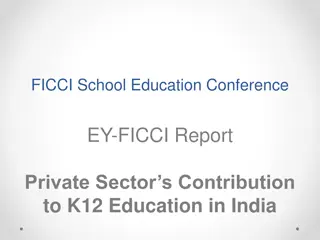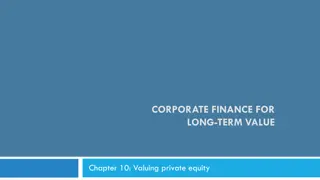
Private Sector-Led Growth in MENA Economies: Challenges and Opportunities
Explore the impact of State-Owned Enterprises (SOEs) on private sector dynamics in the MENA region, and learn about the need for a new state role to foster competition and business dynamism. Discover how SOEs differ from private sector firms and the policy implications for promoting inclusive growth.
Uploaded on | 0 Views
Download Presentation

Please find below an Image/Link to download the presentation.
The content on the website is provided AS IS for your information and personal use only. It may not be sold, licensed, or shared on other websites without obtaining consent from the author. If you encounter any issues during the download, it is possible that the publisher has removed the file from their server.
You are allowed to download the files provided on this website for personal or commercial use, subject to the condition that they are used lawfully. All files are the property of their respective owners.
The content on the website is provided AS IS for your information and personal use only. It may not be sold, licensed, or shared on other websites without obtaining consent from the author.
E N D
Presentation Transcript
Fostering Private Sector Led Growth in MENA: A New Role for the State SEPTEMBER 2023 SuchananTambunlertchai, Monica Petrescu (both IMF), Mahdi Ansari (UMN) IMF IMF | Middle East and Central Asia Department 1
Outline Outline Background: Large footprint of the state in MENA economies, particularly through myriad of SOEs. Empirical evidence: How do SOEs differ from private sector firms? How does SOE presence affect private sector dynamics? Policy implications: New role of the state to facilitate competition and business dynamism. Chapter in Promoting Inclusive Growth in the Middle East and North Africa IMF IMF | Middle East and Central Asia Department 2
Development models based on state capitalism left large Development models based on state capitalism left large state footprints in MENA, and may be reaching their limits state footprints in MENA, and may be reaching their limits Productivity has been declining across the region. and the public wage bill is highest among world regions. The share of public consumption in MENA is sizeable Public Consumption (Share of total) Public Sector Wage Bill (Percent of GDP) Total Factor Productivity Growth (Percent year-on-year) Sources: World Economic Outlook; Penn World Table 9.1 and IMF staff calculations National Accounts and IMF staff calculations. Note: AFR= Sub-Saharan Africa; WHD = Western Hemisphere; APD= Asia and Pacific; CCA = Caucasus and Central Asia; EMDE = Emerging market and developing economies. IMF IMF | Middle East and Central Asia Department 3
Disproportionately high number and market presence of Disproportionately high number and market presence of SOEs across many sectors in MENA SOEs across many sectors in MENA MENA SOEs especially active in trade, transport, ICT, and mining. Large number of SOEs in MENA compared to peers. Sectoral Asset Share of SOEs (2006-2018 average) Number of SOEs (2019 or latest available) Sources: Orbis and IMF staff calculations. Note: Note. Ag = Agriculture; Cnst = Construction; FinS = Other Financial Services; MCh = Chemicals Manufacturing; MMt = Other Materials Manufacturing; MOt = Other Manufacturing; Min = Mining; MonI = Monetary Intermediation; OSv = Other Services; Res = Real Estate; Trd = Trade & Repair; Tsp = Transportation & Storage; Utl = Utilities & Sanitary; Whole = All sectors. IMF IMF | Middle East and Central Asia Department 4
SOEs benefit from fiscal and administrative advantages SOEs benefit from fiscal and administrative advantages SOEs report facing fewer difficulties with permits, access to land, or taxes. Direct fiscal support to SOEs is significant across the region and government guarantees can be sizeable. Direct Fiscal Support to SOEs (2019, percent of GDP) Stock of Government Guarantees to SOEs (2020, as percent of GDP) Obstacles Reported by Firms (percent of firms reporting as major constraint) Sources: State-Owned Enterprises in Middle East, North Africa, and Central Asia: Size, Costs, and Challenges , IMF 2020; and WB Enterprise Surveys. IMF IMF | Middle East and Central Asia Department 5
Advantages received by SOEs may create distortions Advantages received by SOEs may create distortions and affect private sector development and affect private sector development Impact on private sector SOE Advantages Cheaper and more ample access to credit Reduced private sector investment Inefficient allocation of resources Administrative advantages (ability to bypass red tape) Reduced entry/dynamism Large capital and market share upon entry Reduced competition in input and output markets IMF IMF | Middle East and Central Asia Department 6
Quantifying the relationship between SOEs and Quantifying the relationship between SOEs and private sector firms private sector firms Methodology: empirical analysis using firm-level balance sheet data from Orbis; panel of annual data (2006-2018) with more than 50 million observations in 74 countries. 1. How do SOEs differ from private sector firms? Interest costs; profitability. 2. Do these differences suggest resource misallocation? Productivity in use of resources. 3. How does the presence of SOEs affect competition, business dynamism and private sector investment? IMF IMF | Middle East and Central Asia Department 7
Differences between SOEs and private sector firms Differences between SOEs and private sector firms suggest potential resource misallocation suggest potential resource misallocation Productivity Imputed Interest Rate Profitability Ri,t RoEi,t -50.3*** (0.64) -0.40** (.0014) RoKi,t -587.3*** (207.9) -0.99 (1.82) SOE -0.31*** (0.26) 0.016 (0.014) Consistent with better access to credit, SOEs face lower interest costs (0.3 percentage points) than private sector counterparts. Age Age x SOE 0.38*** (0.0029) 5.93* (1.82) SOEs are also less profitable than private sector counterparts. Size -.042 (0.072) -1.16*** (0.0092) 8.17 (14.0) Size x SOE 2.12*** (0.039) (12.1) (12.0) In MENA, SOEs are also less productive in using capital than their private sector counterparts, which, combined with lower interest rates, suggest resource misallocation. Firm-level controls Sector-level controls Fixed effects Country x Sector Country x Year Country x Sector Country x Year Country x Sector Country x Year Region World World MENA Observations R-squared 39mn 0.041 39mn 0.041 53k 0.00041 Note: Robust standard error in parentheses. *** p<0.01, ** p<0.05, * p<0.1 Firm and sector level controls include firm size, age, leverage, current asset ratio, equity ratio, and stock turnover, and interactions between SOE and firm age and size. Sectoral controls include market concentration, entry rate, and investment rate. IMF IMF | Middle East and Central Asia Department 8
A larger SOE presence reduces competition through A larger SOE presence reduces competition through higher market concentration higher market concentration Output market Capital market Labor market SOE presence measured as share of total assets in a sector held by SOEs HHIc,s,t HHIc,t (capital) HHIc,t (labor) SOE sharec,s,t 0.095*** (0.012) -0.038 (0.087) -0.35** (0.17) Larger SOE presence associated with higher concentration in output markets globally(with the relationship significantly stronger in MENA) MENA x SOE sharec,s,t 0.16*** (0.052) Country Sector Year 0.80*** (0.14) Country Year 0.89*** (0.27) Country Year Fixed effects Larger SOE presence associated with higher concentration in input markets (both capital and labor) in MENA Region World World World Observations R-squared 8,504 0.408 917 0.593 917 0.476 Note: SOE share represents share of sector assets owned by SOEs. Robust standard error in parentheses. *** p<0.01, ** p<0.05, * p<0.1 IMF IMF | Middle East and Central Asia Department 9
A larger SOE presence reduces private sector A larger SOE presence reduces private sector dynamism and investment dynamism and investment Entrys,t Exits,t Investmenti,t SOE sharec,s,t -0.021* (0.0012) -0.011*** (0.0043) -594.6* (343.93) Larger SOE presence is associated with reduced business dynamism (lower entry and exit rates) for private sector firms. HHIc,s,t 0.0017 (.0016) 0.025** (0.011) -912.9 (1166) Firm-level controls Sector-level controls Fixed effects Larger SOE presence is also associated with lower investment by private sector firms in MENA. Country Sector Year Country Sector Year Country x Sector Country x Year Region World World MENA Observations R-squared 8,504 0.035 7,820 0.041 45k 0.0051 Note: SOE share represents share of sector assets owned by SOEs. Entry (exit) represent share of first in the first (last) year. Robust standard error in parentheses. *** p<0.01, ** p<0.05, * p<0.1 IMF IMF | Middle East and Central Asia Department 10
Conclusions Conclusions SOEs differ from private sector firms: Benefit from certain advantages, e.g., lower interest rates; Less profitable and less productive. Higher SOE presence in a sector is associated with: Lower competition in input and output markets; Lower dynamism; Lower private investment. IMF IMF | Middle East and Central Asia Department 11
Policy Implications Policy Implications Rolling back the state s role can lead to greater efficiency, higher productivity, and hence strengthen the economy s ability to sustain higher growth; in MENA, state should pivot towards facilitating (rather than leading) business activities. Improving governance, transparency, and accountability for SOEs could help improve SOE efficiencies. Need for a competition and labor market policies that ensure competitive neutrality between public and private sectors and encourage private sector participation. Reducing barriers to entry/costs of doing business, e.g., by streamlining business licensing requirements. Labor market policies that facilitate labor reallocations from public sector and low-productivity services to more productive sectors. IMF IMF | Middle East and Central Asia Department 12
Thank you! IMF IMF | Middle East and Central Asia Department 13
Back up slides IMF IMF | Middle East and Central Asia Department 14
Different life cycle dynamics for SOEs vs. private firms Different life cycle dynamics for SOEs vs. private firms SOEs are larger in size upon establishment, in terms of both assets and sales, but grow more slowly than private sector firms IMF IMF | Middle East and Central Asia Department 15 Sources: IMF analysis of Orbis data.






















